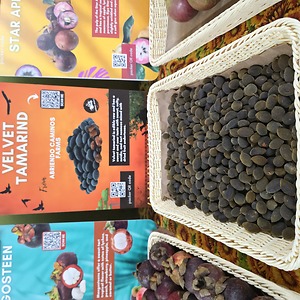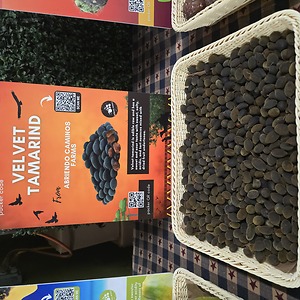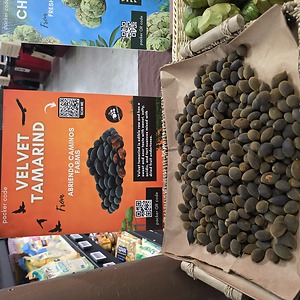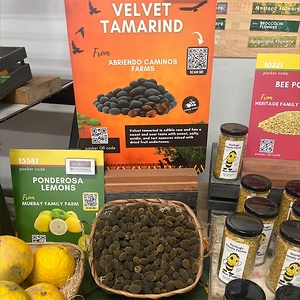


Velvet Tamarind
Estimated Inventory, lb : 1.01
This item was last sold on : 06/29/25
Description/Taste
Velvet tamarind is small in size, averaging 1.8 to 2 centimeters in length and 1.3 to 1.5 centimeters in diameter, and has an ovoid to round, curved shape with blunt ends. The fruits are slightly flattened and enveloped in a dark brown-black, hard, inedible shell. This shell is thin and brittle, cracking under gentle pressure, and has a velvety, fuzzy appearance. Inside the shell is a layer of pulp surrounding 1 to 2 seeds. The pulp is not adhered to the shell, and if the fruit is shaken, a faint rattling can be heard. Depending on the variety, the pulp ranges in color from burnt orange to brown-black to dark brown and has a powdery, paste-like consistency. Some varieties are drier in texture than others, and the pulp is eaten by sucking on the flesh, discarding the 1 to 2 seeds inside. Most fruits have one seed, around 7 to 8 millimeters long, which is shiny, firm, and dense. Velvet tamarind is edible raw and has a sweet and sour taste with sweet, salty, acidic, and tart nuances mixed with dried fruit undertones.
Seasons/Availability
Velvet tamarind is harvested in Africa from October through January and March to May, depending on the region and climate. Some species also ripen in Southeast Asia from January through April.
Current Facts
Velvet tamarind, botanically a part of the Dialium genus, is a general term used for several species belonging to the Fabaceae family. There are three main species known as Velvet tamarind native to Southern Asia, Southeast Asia, and Africa, and these species all produce edible fruits sold in local markets for culinary and medicinal use. Dialium cochinchinense and Dialium indium are species found in Southern and Southeast Asia, while Dialium guineense is native to Africa. Velvet tamarind grows in loose hanging clusters on tropical, evergreen trees reaching 25 to 35 meters in height, and the fruits are primarily foraged from wild trees. Velvet tamarind is not commercially produced and faces the threat of extinction in some regions due to deforestation and the removal of trees from private properties. The trees also grow slowly and are cut down for their valuable fine-grained wood. Velvet tamarind is sold fresh or dried as an on-the-go snack and purchased for use in beverages, preserves, and chutney. In Asia and Africa, Velvet tamarind is known by many regional names, including Keranji or Buah Keranji in Indonesia and Malaysia, Keran-keran, Keranji madu, and Keranji bernang in Borneo, Luk Yee or Yee in Thailand, Awin, Tsamiyar, Icheku, and Igbaru in Nigeria, Black Tombla in Sierre Leone, Veuldo in Senegal, Yoyi in Ghana, Atchethewh in Togo, and Assiswe in Benin. It is important to note that Velvet tamarind is in the same family as tamarind, Tamarindus indica, but the fruits are distinct species and only distantly related. Velvet tamarind acquired its tamarind moniker from its similar flavor to tamarind.
Nutritional Value
Velvet tamarind is a source of vitamin C to boost the immune system, magnesium to control nerve functions, calcium to build strong bones and teeth, and fiber to regulate the digestive tract. The fruit pulp also provides potassium to balance fluid levels, vitamin A to maintain healthy organ functioning, iron to develop the protein hemoglobin for oxygen transport through the bloodstream, and manganese to generate connective tissues. Velvet tamarind is also used in natural medicines throughout Asia and Africa for its anti-inflammatory, antifungal, and antimicrobial properties. The fruits are consumed to aid in digestive issues, lessen headaches, and treat the liver, and the leaves are used as a natural diuretic. The young leaves are also applied topically to the skin to heal irritations and wounds, and the oil from the seeds is incorporated into skincare products.
Applications
Velvet tamarind has a sweet-tart, subtly acidic, and sour flavor suited for raw or cooked preparations. The fruits are consumed out of hand, discarding the exterior brittle shell, and the flesh is sucked from the seeds. Velvet tamarind is a popular seasonal snack throughout Southeast Asia, especially in Malaysia and Indonesia, and the fruits are often sprinkled with sugar and chili powder and rolled into leaves as a street food. Velvet tamarind is also added to various chutney recipes and sauces, or it is dried for extended use as a shelf-stable product. In addition to fresh preparations, Velvet tamarind is soaked in water and added to beverages. The fruits can be macerated and consumed as a stand-alone drink, or the mixture can be stirred with other fruit juices. In West Africa, ogogoro is a type of palm wine often sprinkled with ground Velvet tamarind dust for added flavoring. Velvet tamarind is also simmered into syrups, jams, and jellies or can occasionally be incorporated into candies and desserts. Beyond the fruits, the young leaves are cooked into domoda, an African peanut stew, or eaten as a leafy vegetable. The leaves are also steeped into tea. In some communities, the seasonal flowers of the plants are added to salads and used as a garnish. Velvet tamarind pairs well with aromatics such as garlic, ginger, shallots, and onions, fruits including mangos, citrus, and pineapple, vanilla, soy sauce, and honey. Whole, unopened Velvet tamarind will keep for several weeks when stored in a cool, dry, and dark place. It is recommended to immediately consume the fresh fruits for the best quality and flavor. The fruits can also be properly dried and stored for extended use.
Ethnic/Cultural Info
Velvet tamarind trees are known for their valuable, rare timber called Keranji, Nyamut, Kaerandji, Kheng, and Yi-Thongbung in Southeast Asia. The wood is heavy, dense, durable, and prized for its fine-grained nature. Velvet tamarind tree logs are so heavy that rivers cannot transport them as they sink to the bottom. Many axe blades also become dulled before they can cut down the tree, leading the harvesting of the wood to be a challenging process. Despite these hardships, Kernaji wood is revered for flooring and heavy construction projects. The wood is used for beams, joints, rafters, or handles of tools, pestles, and benches.
Geography/History
Velvet tamarind describes three main species of the Dialium genus native to regions of Southern Asia, Southeastern Asia, West Africa, and Central Tropical Africa. The various species have been growing wild since ancient times and naturally spread through human and animal interactions. The flesh of the fruits is a favored food of animals, and the seeds are scattered in the animals' fecal matter, broadening the range of the plants. Velvet tamarind seeds can also float, venturing along ocean currents. Throughout history, Velvet tamarind has remained chiefly a wild species as the trees grow slowly. The fruits are foraged from wild trees and are used medicinally or consumed as a food source. Today, Velvet tamarind is found in lowland forests, rainforests, partially shaded areas, swamps, savannahs, and hillsides up to 1,200 meters in elevation. The fruits are somewhat in danger of becoming extinct, as many trees have been cut down due to deforestation and urbanization, and growers have ripped their trees out as the fruits are not considered a profitable crop. When in season, Velvet tamarind is sold through select markets in West Africa, especially in Nigeria, Benin, Ghana, Togo, Sierra Leone, Senegal, and Guinea-Bissau. The fruits are also found in Thailand, Vietnam, Laos, Myanmar, Cambodia, Sri Lanka, Malaysia, and Indonesia.











